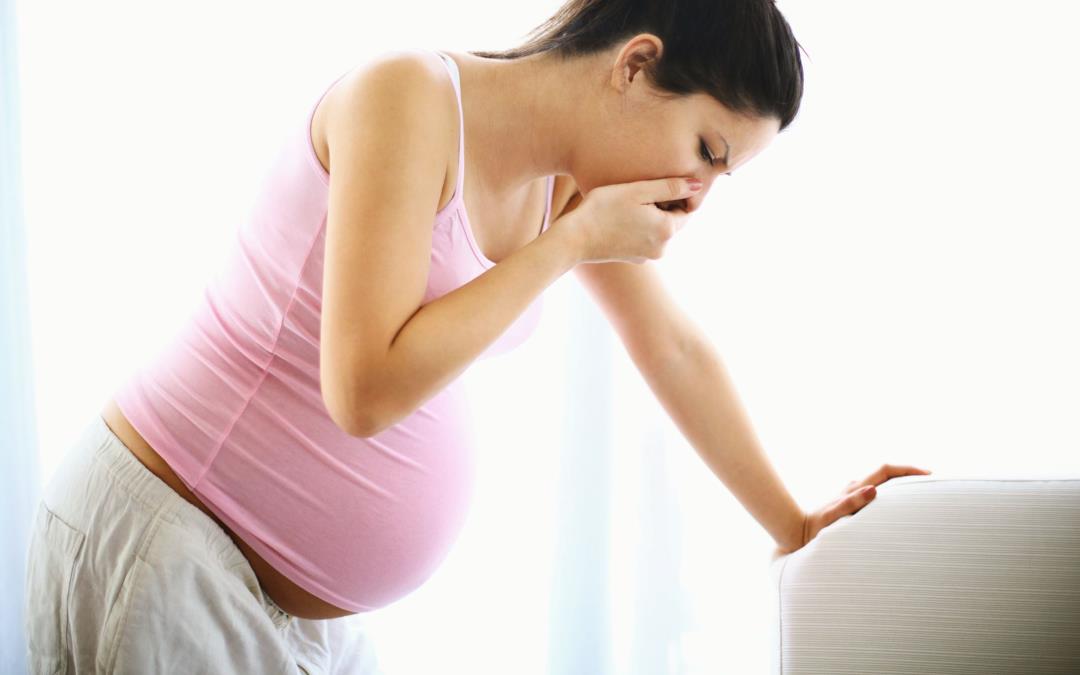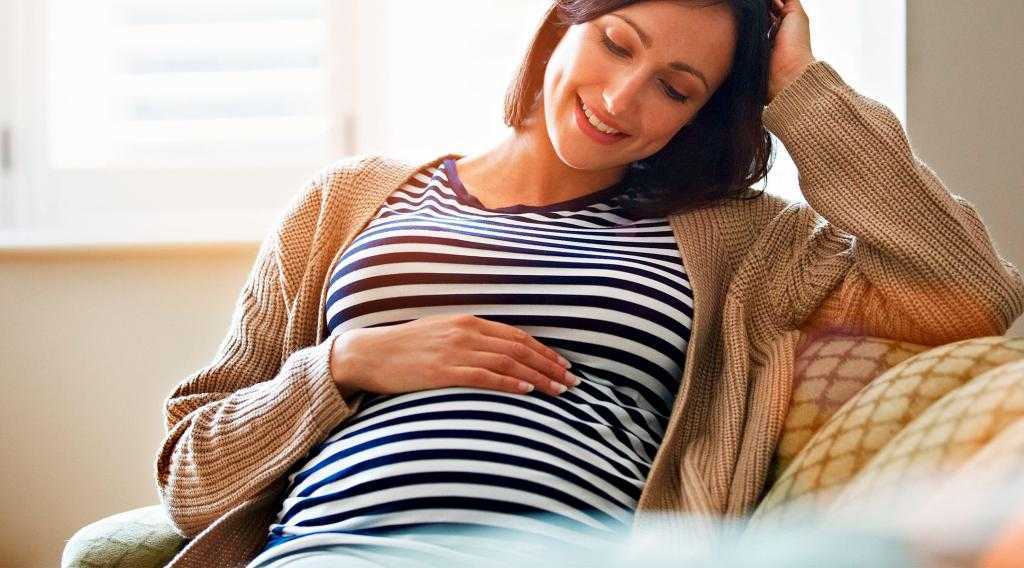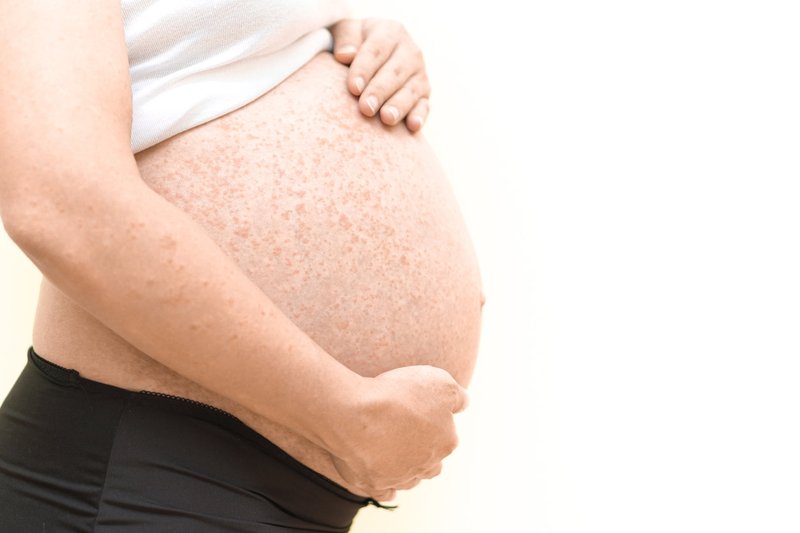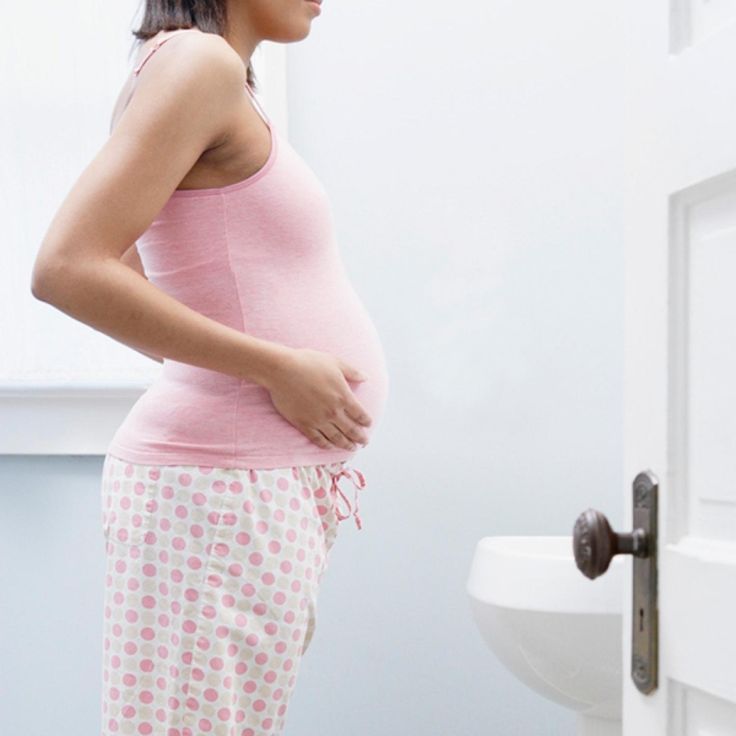Itchy at end of pregnancy
Itching and intrahepatic cholestasis of pregnancy
Itching is common in pregnancy. Usually it's thought to be caused by raised levels of certain chemicals in the blood, such as hormones.
Later, as your bump grows, the skin of your tummy (abdomen) is stretched and this may also feel itchy.
However, itching can be a symptom of a liver condition called intrahepatic cholestasis of pregnancy (ICP), also known as obstetric cholestasis (OC).
ICP needs medical attention. It affects 1 in 140 pregnant women in the UK.
Symptoms of ICP
The main symptom is itching, usually without a rash. For many women with ICP, the itching is often:
- more noticeable on the hands and feet, but can be all over the body
- worse at night
Other symptoms can include:
- dark urine
- pale poo
- yellowing of the skin and whites of the eyes (jaundice), but this is less common
Symptoms of ICP typically start from around 30 weeks of pregnancy, but it's possible to develop the condition as early as 8 weeks.
Non-urgent advice: Call your midwife or GP if you have itching that's:
- mild or distressing, possibly worse at night
- anywhere on your body, but may be worse on the palms of your hands and soles of your feet
Feeling itchy like this can be a sign of ICP and needs to be checked.
Mild itching
Wearing loose clothes may help prevent itching, as your clothes are less likely to rub against your skin and cause irritation.
You may also want to avoid synthetic materials and opt for natural ones, such as cotton, instead. These are "breathable" and allow the air to circulate close to your skin.
You may find having a cool bath or applying lotion or moisturiser can help soothe the itching.
Some women find that products with strong perfumes can irritate their skin, so you could try using unperfumed lotion or soap.
Mild itching is not usually harmful to you or your baby, but it can sometimes be a sign of a more serious condition, particularly if you notice it more in the evenings or at night.
Let your midwife or doctor know if you are experiencing itching so they can decide whether you need to have any further investigations.
Intrahepatic cholestasis of pregnancy
Intrahepatic cholestasis of pregnancy (ICP) is a potentially serious liver disorder that can develop in pregnancy.
Normally, bile acids flow from your liver to your gut to help you digest food.
In ICP, the bile acids do not flow properly and build up in your body instead. There's no cure for ICP, but it should go once you've had your baby.
ICP seems to run in families, but it can happen even if there is no family history. It is more common in women of south Asian origin, affecting around 1 in 70 to 80 pregnancies.
It is more common in women of south Asian origin, affecting around 1 in 70 to 80 pregnancies.
If you have had ICP in a previous pregnancy, you have a high chance of developing it again in another pregnancy.
Some studies have found that babies whose mothers have ICP have a higher chance of being born prematurely or stillborn.
Because of the link with stillbirth, you may be offered induction of labour. This could be any time from 35 weeks, depending on the level of bile acids in your blood.
If you have ICP, you will probably be advised to give birth in hospital under a consultant-led maternity team.
Diagnosis and treatment of ICPICP is diagnosed by excluding other causes of the itch. Your doctor will probably talk to you about your medical and family history and order a variety of blood tests.
These will include tests to check your liver function (LFT) and measure your bile acid levels (BA).
If you are diagnosed with ICP, you will have regular liver function tests so your doctor can monitor your condition.
There is no agreed guideline on how often these tests should happen, but the Royal College of Obstetricians & Gynaecologists (RCOG) and the British Liver Trust advise weekly tests.
ICP Support, the UK's largest research group investigating ICP, also recommends weekly bile acid measurements. These readings help doctors recommend when your baby should be born.
If your LFTs and bile acids are normal and you continue to have severe itching, the blood tests should be repeated every week or 2, to keep an eye on them.
Creams and medicines for ICPCreams, such as aqueous cream with menthol, are safe to use in pregnancy and can provide some relief from itching.
There are some medicines, such as ursodeoxycholic acid (UDCA), that help reduce bile acids and ease itching.
UDCA is considered safe to take in pregnancy, although it is prescribed on what is known as an "informed consent" basis as it has not been properly tested in pregnancy.
You may also be offered a vitamin K supplement. This is because ICP can affect your absorption of vitamin K, which is important for healthy blood clotting.
Most experts on ICP only prescribe vitamin K if the mother-to-be reports pale stools, has a known blood clotting problem, or has very severe ICP from early in pregnancy.
If you are diagnosed with ICP, your midwife and doctor will discuss your health and your options with you.
Further information
The Royal College of Obstetricians & Gynaecologists (RCOG) has more information about obstetric cholestasis, including what it means for you and your baby, and the treatment that's available. You can also get information about ICP from the British Liver Trust.
You can also get information about ICP from the British Liver Trust.
The charity ICP Support provides information about ICP. You can also watch their video about ICP featuring mums and clinical experts.
Community content from HealthUnlockedItching during pregnancy | Pregnancy Birth and Baby
beginning of content3-minute read
Listen
Mild itching is common in pregnancy because of the increased blood supply to the skin. As your pregnancy progresses and as your baby grows, the skin of your abdomen is stretched and this may also feel itchy.
Mild itching is usually nothing to worry about, but if the itching becomes severe it can be a sign of a serious liver condition called obstetric cholestasis. This affects fewer than 1 in 100 pregnant women, but needs medical attention.
This affects fewer than 1 in 100 pregnant women, but needs medical attention.
Mild itching
Wearing loose clothes may help prevent itching, as your clothes are less likely to rub against your skin and cause irritation. You may also want to avoid synthetic materials and choose natural fabrics such as cotton that allow the air to circulate close to your skin. You may find that having a cool bath or applying lotion or moisturiser can help to soothe the itching.
Some women find that products with strong perfumes can irritate their skin, so you could try using plain lotion or soap.
Serious itching: obstetric cholestasis
If you’re worried about your itching, or if you have severe itching, it’s important to see your midwife or doctor.
Obstetric cholestasis (OC), also called intrahepatic cholestasis of pregnancy, is a serious liver disorder that affects a small number of pregnant women, usually in the last 3 months of pregnancy.
Causes of obstetric cholestasis
The cause of OC is unclear, but it’s thought the rise of pregnancy hormones later in pregnancy may slow the normal flow of bile — the digestive fluid made in the liver that helps your digestive system break down fats. In OC, bile salts build up rather than leaving the liver, eventually entering the bloodstream, which can make you feel itchy.
In OC, bile salts build up rather than leaving the liver, eventually entering the bloodstream, which can make you feel itchy.
OC seems to run in families, although it can occur with no family history. It is also more common in women of Indian and Pakistani origin. If you have had OC in a previous pregnancy, you're more likely to develop it again in a subsequent pregnancy.
Babies of women with OC are more likely to be born prematurely or to be stillborn, or to have lung problems from breathing in meconium. Because of these complications, your doctor may consider inducing labour before you are due.
Symptoms of obstetric cholestasis
The classic symptom of OC is itching without rash, usually on the palms and soles of the feet, but it may be more widespread. The itching can be non-stop or unbearable, and worse at night.
Other symptoms include dark urine, jaundice (yellowing of the skin and whites of the eyes), and pale bowel movements (poo).
The itchiness usually goes away within a few days after giving birth.
Treatment of obstetric cholestasis
OC is diagnosed through taking a medical and family history, and blood tests that check your liver function (liver functions tests — LFTs). Once OC is diagnosed, you will have regular LFTs until your baby is born, so that your doctor can monitor your condition.
Creams, such as calamine lotion, are safe to use in pregnancy and can provide some relief from itching. Your doctor may prescribe a medication to reduce bile salts and ease itching.
OC can affect your absorption of vitamin K, which is important for healthy blood clotting so you may be offered a vitamin K supplement.
If you are diagnosed with OC, your midwife and doctor will discuss your health and your options with you.
Sources:
Mayo Clinic (Cholestasis of pregnancy), NSW Health (Having a baby), Royal Women’s Hospital (Common concerns in early pregnancy), SA Health Department (Clinical guideline obstetric cholestasis), Women's and Children's Health Network (Itching in pregnancy), King Edward Memorial Hospital (Cholestasis in pregnancy - clinical guidelines)Learn more here about the development and quality assurance of healthdirect content.
Last reviewed: November 2020
Back To Top
This information is for your general information and use only and is not intended to be used as medical advice and should not be used to diagnose, treat, cure or prevent any medical condition, nor should it be used for therapeutic purposes.
The information is not a substitute for independent professional advice and should not be used as an alternative to professional health care. If you have a particular medical problem, please consult a healthcare professional.
Except as permitted under the Copyright Act 1968, this publication or any part of it may not be reproduced, altered, adapted, stored and/or distributed in any form or by any means without the prior written permission of Healthdirect Australia.
Support this browser is being discontinued for Pregnancy, Birth and Baby
Support for this browser is being discontinued for this site
- Internet Explorer 11 and lower
We currently support Microsoft Edge, Chrome, Firefox and Safari. For more information, please visit the links below:
For more information, please visit the links below:
- Chrome by Google
- Firefox by Mozilla
- Microsoft Edge
- Safari by Apple
You are welcome to continue browsing this site with this browser. Some features, tools or interaction may not work correctly.
Why does the skin itch during pregnancy?
Skin itching during pregnancy is not a very common phenomenon. Most often, the skin begins to itch unbearably (as after mosquito bites) in the evening, closer to night, which can provoke insomnia and generally worsen a woman’s mood. Usually itching does not harm the baby and goes away after childbirth. However, it is still worth consulting with a gynecologist and dermatologist.
What does it come from?
The cause of itching during pregnancy in most cases is a violation of the liver: the production and outflow of bile, a general increase in the level of bilirubin in the blood. This is due to a hormonal failure in the body of the future mother - a violation of the synthesis of estrogens, as well as due to fetal pressure on the bile ducts. The fatty acids produced in large quantities enter the woman's skin with the bloodstream and irritate the nerve endings, causing excruciating itching. Similar phenomena associated with stagnation of bile in the body can make themselves felt in the third trimester of pregnancy. Sometimes itching is accompanied by such dangerous diseases as diabetes mellitus.
This is due to a hormonal failure in the body of the future mother - a violation of the synthesis of estrogens, as well as due to fetal pressure on the bile ducts. The fatty acids produced in large quantities enter the woman's skin with the bloodstream and irritate the nerve endings, causing excruciating itching. Similar phenomena associated with stagnation of bile in the body can make themselves felt in the third trimester of pregnancy. Sometimes itching is accompanied by such dangerous diseases as diabetes mellitus.
Who is predisposed?
Itching during pregnancy is usually observed in women with chronic diseases of the biliary tract and with high levels of cholesterol in the blood. Such future mothers need to regularly (at least once a month) do a biochemical blood test to exclude toxic effects on liver cells.
How to fight?
A pregnant woman should tell her gynecologist about the discomfort associated with skin itching. In some cases, itching can be a sign of the development of such a dangerous disease as hepatitis. The doctor will conduct appropriate examinations. If, according to an objective examination, itching does not pose any danger, it is often possible to get rid of discomfort simply by following a diet aimed at lowering cholesterol levels, limiting the intake of fatty, spicy and salty foods that prevent the liver from coping with the function of bile secretion, as well as drinking plenty of water - it is necessary to eliminate dry skin. If the diet does not help, the doctor may prescribe choleretic drugs suitable for pregnant women.
The doctor will conduct appropriate examinations. If, according to an objective examination, itching does not pose any danger, it is often possible to get rid of discomfort simply by following a diet aimed at lowering cholesterol levels, limiting the intake of fatty, spicy and salty foods that prevent the liver from coping with the function of bile secretion, as well as drinking plenty of water - it is necessary to eliminate dry skin. If the diet does not help, the doctor may prescribe choleretic drugs suitable for pregnant women.
It is important to find the cause of the bothersome itching, eliminating a whole group of skin diseases that can occur during pregnancy.
Itching in the abdomen and chest
This itch is worth mentioning separately. As a rule, the skin on the abdomen or chest itches in the second and third trimesters due to its stretching, because it is these parts of the body that increase in volume during pregnancy. In this case, it is very important not to scratch the skin - this will lead to the appearance of stretch marks, which, unlike itching, will not go away after childbirth. Regularly use moisturizing creams, special products for stretch marks, do a light massage of the chest and abdomen with circular movements of your fingers and do not take hot showers.
You can get answers to any questions about pregnancy and childbirth from leading EMC experts in the classes of the School of Moms.
Subscribe to our Instagram. You will find useful information about pregnancy and childbirth from leading EMC obstetricians and gynecologists.
On the issue of intrahepatic cholestasis syndrome in pregnant women | #06/03
Cholestasis of pregnancy (CP) is a relatively benign disease characterized by itchy skin, usually associated with mild cholestatic jaundice. HB develops, as a rule, in the III trimester of pregnancy and quickly disappears after childbirth. The frequency of chronic bronchitis is one case per 2000-6000 pregnant women.
The etiology and pathogenesis of cholestasis of pregnancy is still being discussed. It is assumed that genetic factors play a significant role in its development (there are family cases of the disease). In women with chronic kidney disease, there appears to be a genetically determined hypersensitivity to estrogens. An increase in the content of estrogen in the body of these women leads to the development of cholestasis. Pregnancy, therefore, plays the role of a trigger factor - it is known that by the end of a normal pregnancy, the content of estrogens in the body increases 1000 times. It is believed that the pathogenesis of CP is based on an adaptive anabolic reaction of hepatocytes: in particular, increased cholesterol synthesis in the liver, associated with endocrine changes developing in the body. In persons with a certain constitutional predisposition, these changes lead to a violation of bile formation and bile secretion.
Morphological examination of the liver tissue shows minimal changes in the form of signs of centrilobular cholestasis (the presence of bile clots and dilation of the bile capillaries, bile pigment in hepatocytes). Necrobiotic, inflammatory changes are absent in most cases. Electron microscopically reveals typical changes characteristic of intrahepatic cholestasis (expansion of bile capillaries, loss of microvilli, accumulation of pigment in the cytoplasm of cells).
Clinical symptoms of the disease appear in most cases in the last trimester of pregnancy and only in 20-30% of cases - in the II trimester. The most important symptom is itching of the skin (pruritas), which is worse at night. Sometimes it is so painful that it is necessary to artificially terminate the pregnancy. In typical cases, jaundice occurs one to two weeks after the onset of pruritus, often even later, and in some cases is completely absent. Jaundice is often mild or moderate, reaches a maximum within a few days and remains almost constant until delivery. Other symptoms may include nausea, weakness, loss of appetite, discomfort in the right hypochondrium (rare). The size and consistency of the liver in most cases do not change, the spleen does not increase. Darkening of urine is characteristic, at the same time, lightening of feces is observed only in individual patients. Symptoms of the disease disappear only after childbirth - first itching disappears (usually within one to two days, rarely up to two weeks), and then jaundice (usually in one to two weeks, but no later than four weeks) [2 , 7, 10].
Pregnant women with cholestatic jaundice always require special attention of therapists and obstetrician-gynecologists. Practitioners experience great difficulties, both in differentiating subhepatic and intrahepatic cholestasis, and in carrying out therapeutic measures and deciding on the preservation of pregnancy. A risk factor for the development of exacerbations or complications in case of liver damage due to pregnancy is the presence of signs of activity of the liver process and / or cholestasis before it occurs.
Cholestasis of pregnancy implies the presence of cholestatic hepatosis underlying the disease. However, we believe that with recurrent cholestasis against the background of repeated pregnancy, under unfavorable conditions, steatohepatitis may also develop, as evidenced by a significant increase in transaminases and other markers of cytolysis, and the severity of the mesenchymal inflammatory syndrome.
According to VI Ivashkin [3], which we fully share, there are various clinical variants of cholestasis in pregnant women. The first option is single-component, or partial bilirubin, cholestasis, in which the formation and secretion of bilirubin are predominantly disturbed, skin itching occurs, while other biochemical parameters of cholestasis are not very pronounced, that is, the formation and secretion of other bile components are preserved. The second variant of cholestasis is partial choleacid, in which the mechanism responsible for the acceptance or secretion of bile acids during the normal transport of the remaining bile components is predominantly affected. The prognosis for this option is always worse.
Excruciating itching, disturbing neurological status, hemorrhagic manifestations due to impaired absorption of fat-soluble vitamins pose a threat of premature birth, postpartum hemorrhage, and hypoxia against the background of cholemia leads to fetal malnutrition.
These patients come to a hepatologist after a long and unsuccessful treatment by a dermatologist and an allergist for pruritus. When jaundice occurs, general practitioners regard the current situation, especially in the presence of "spider veins" (which happens quite often with hyperestrogenism), as a manifestation of hepatitis and either send such patients to an infectious diseases hospital, or begin therapy with hepatoprotectors and, even worse, choleretics, moreover outdated and unreliable medications are often used. Meanwhile, it is known that some hepatoprotectors can aggravate cholestasis, causing a "blocking" effect of the biliary pole of the hepatocyte.
Diagnosis of CP in some cases presents significant difficulties, since each patient has a complete set of cholestasis markers (an increase in direct bilirubin, cholesterol (CH), alkaline phosphatase (AP)) [1, 2].
In 37 patients who were followed up, the syndrome of intrahepatic cholestasis was verified. These were women aged 17 to 36, 10 of them had a second pregnancy. Of these, 24 women were referred to the clinic by internists, three by infectious disease specialists, two by neuropathologists, one by a geneticist, four by a hematologist, and three were transferred from surgical departments.
Twenty pregnant women were diagnosed with chronic hepatitis, four with hepatitis with transition to cirrhosis, three with Wilson-Konovalov disease, two with cirrhosis of the liver, and eight with cholestasis of pregnancy.
During the examination in the hospital, all patients were consulted by an infectious disease specialist and a hematologist, a study was carried out for markers of hepatitis B and C. At the same time, the diagnosis in the "chronic hepatitis" group was revised in most patients (12), cytomegalovirus infection and hepatitis were detected in one patient, in two patients microspherocytosis was diagnosed, jaundice was of a mixed nature, Wilson-Konovalov's disease was confirmed in three patients, hepatomegaly and intrahepatic cholestasis developed in two women during treatment with tuberculostatics and thyreostatics. Thus, the largest group (16 people) consisted of patients with intrahepatic cholestasis (eight people from the "chronic hepatitis" group).
50% of patients with idiopathic cholestasis of pregnancy had a second pregnancy, 25% of women had two or three pregnancies earlier, which ended either in the birth of a dead fetus, or spontaneous miscarriages in the early stages, or there were signs of intrauterine hypoxia and malnutrition in newborns who died on the first month of life.
Verification of diagnoses in pregnant women with cholestasis was carried out on the basis of anamnestic data, laboratory parameters in addition to routine studies: bilirubin, cholesterol, alkaline phosphatase; Emphasis was placed on the most subtle marker of cholestasis - the level of bile acids (BA), which was studied using modern techniques in the radioisotope laboratory. The sensitivity of the method is 0.1 mmol/l. For the norm of fatty acids were taken indicators of 0-600 mcg/l. The study of β 2 - microglobulin and ferritin, which was also carried out in the RILS.
Enzymograms, which are reliable and highly informative indicators of cytolysis, were used to assess the functional state of the liver. This is a set of tests with the determination of the activity of liver-specific enzymes: fructose-1-phosphate aldolase, urocaninase, histidase, serine and threonine dehydratase, in some patients the activity of serum cholinesterase was studied. Echohepatograms were studied, data from previous hospitalizations were used, where hepatoscintigraphy, biliscintigraphy, histological studies of liver biopsy specimens, cholecystography, as well as hemorheology and the state of intrahepatic hemodynamics were analyzed.
Of course, there were certain difficulties in diagnosing cholestasis that develops during pregnancy. Sometimes patients have only pruritus, persistent and painful, which does not go away for several weeks. Itching preceded the development of jaundice (three patients), which made us think about skin diseases, allergies, helminthic invasion, nervous diseases. Six patients had persistently elevated alkaline phosphatase and thymol test with subnormal bilirubin levels, and later pruritus appeared. More than 50% of the observed FA concentration was 10-20 and even 40 times higher than normal (in two patients). The longer the cholestasis was, the more often hemorrhagic syndrome was detected with a decrease in the prothrombin-forming function of the liver, which, apparently, is associated with impaired absorption of fat-soluble vitamins, and rheology and hemocirculation disorders in the liver were more often detected.
In no case during pregnancy, a needle biopsy of the liver was performed, although it is recommended in the early stages as part of the examination [1]. Two patients with liver cirrhosis (LC) earlier, before pregnancy, had a morphological confirmation of the diagnosis.
At the same time, it should be noted that pregnancy against the background of cirrhosis and chronic hepatitis with severe activity (CHVA) is the most dramatic. Not without reason, 10-15 years ago, both internists and obstetrician-gynecologists wrote that these diseases and pregnancy are incompatible concepts. Although in recent years contraindications concern only severe and accompanied by high activity, as well as decompensation of liver diseases, today, however, there is still a high risk of complications both during pregnancy and in childbirth.
N. A. Farber et al. [4] indicate that 20% of women manage to endure pregnancy against the background of cirrhosis, up to 38% of women with CHVA, while preterm births are observed in more than 50% of them, every fifth has a stillborn fetus, from 6-27% - spontaneous miscarriages. Patients with cholestasis often develop cholemic bleeding, DIC before childbirth, during childbirth, and even after childbirth.
Below are the results of clinical observation. Patient T., 19 years old, with no history of diseases of the hepatobiliary system, applied for pregnancy (28 weeks) to the antenatal clinic, the results of the examination were favorable.
At 32 weeks, weakness, pruritus appeared, a moderate decrease in hemoglobin was observed. The patient refused further examination.
She carried the child to the due date, after the birth the condition deteriorated sharply. Skin itching did not stop, jaundice appeared (bilirubin level up to 187.6 µmol/l with a predominance of direct - 143.2 µmol/l), when examined by a therapist, skin hemorrhages and hepatolienal syndrome were found. The patient was hospitalized in an infectious disease hospital with suspected viral hepatitis: this diagnosis was ruled out after a week. Hepatitis B and C markers were negative, the patient was transferred to OKB No. 1 with a diagnosis of chronic hepatitis. Considering a number of signs: pronounced skin “liver signs”, a dense enlarged liver and spleen, an increase in ferritin up to 1300 ng / ml (more than 100 times) and β 2 - microglobulin up to 37 mg/ml, edematous-ascitic syndrome, we suspected hepatitis of an autoimmune nature with an outcome in the liver. Intensive therapy was prescribed: hemodez, rheopolyglucin, prednisolone up to 200 mg/day, essentiale 10 ml intravenously, solcoseryl 10 ml intravenously, heptral, trental, but the patient's condition did not improve, five days later a typical DIC syndrome developed with a clinic of non-cardiogenic edema lungs.
The patient was transferred to the intensive care unit, where, despite active therapy - plasmapheresis, megadoses of prednisolone, infusions of fresh frozen plasma, contracal, mechanical ventilation - two days later, death occurred. Autopsy showed cirrhosis with multiple fresh necrosis. Thus, the disease, which was latent in the patient, progressed against the background of pregnancy. After childbirth, the rapid development of edematous-ascitic syndrome and liver failure led to a fatal outcome. Not the last role in this was played by the lack of targeted examination and treatment at the place of residence.
Patients with chronic hepatitis (CH) and cholestasis during pregnancy had a clinic of increasing cholemia with severe skin itching, scratching, pyoderma, persistent insomnia, anorexia. Despite adequate detoxification therapy, their health did not improve, the level of bilirubinemia was high, an increase in the activity of liver-specific enzymes, cholesterol levels, hypocoagulation caused the appointment of glucocorticoids in such patients. In moderate doses (30-40 mg/day), they do not have a toxic, teratogenic and abortive effect. The gestational age ranged from 10 to 14 weeks. However, despite complex therapy, the condition progressively worsened, and the pregnancy had to be terminated with subsequent complex intensive therapy, including efferent methods.
Patients with cholestasis of pregnancy - eight women with terms of 14-16 weeks - safely endured pregnancy and were resolved at term with full-term healthy children. All of them had re-pregnancy, they received both outpatient and inpatient treatment.
More serious was the situation when women with cholestasis were admitted to the hospital in the second half of pregnancy. Often this was an unfavorable background for conception: two had severe anemia; three have unfavorable occupational factors; some patients received outpatient treatment with unidirectional drugs (Essentiale, Carsil, Legalon, Silibor), which aggravated the symptoms of cholestasis.
These patients had more pronounced hyperbilirubinemia, up to 80-100 µmol/l, in 80-100% - an increase in transaminase activity by one and a half to two times; all patients showed an increase in the level of β 2 -microglobulin, ferritin.
The concentration of fatty acids increased 10-20 times, one patient had a 100-fold increase. The activity of alkaline phosphatase in 50% of patients was exceeded by one and a half to two times, hypercholesterolemia was detected in every third patient. Apparently, these pregnant women had deeper morphological changes in the liver. Attention was drawn to a significant decrease in hepatic blood flow according to rheohepatography and scintigraphy, a tendency to hypocoagulation. In the treatment, intravenous administration of lipostabil, gemodez, rheopolyglucin, intake of enterosorbents, "bile thinners" (mineral water "Ergeninskaya", herbal teas) was used. In this group, pregnancy was reported by four patients, early delivery was in two patients, and another two had early delivery. Due to the increased symptoms of cholestasis, all patients were subsequently re-examined in the clinic, two patients successfully underwent intravenous ozone therapy (IVOT), four patients received therapy with antioxidants, tykveol, and light hepatorotectors of plant origin (hepabene, hepatofalk planta) with a positive effect.
Ursodeoxycholic acid (UDCA, ursofalk) has been successfully used throughout the world for a number of years as the main pathogenetic agent in cholestasis of pregnancy, an essential link in the pathogenesis of which is the delay and violation of the composition of bile acids, the aggravation of immunological damage to the bile ducts by hydrophobic bile acids. UDCA is a natural non-toxic hydrophilic bile acid that is an integral part of the human FA pool. The mechanisms of action of UDCA are diverse and not fully understood. The main ones can be considered cytoprotective and choleretic effects caused by a change in the pool of bile acids with the displacement of UDCA of toxic primary fatty acids (such as chenodeoxycholic, deoxycholic, lithocholic), the absorption of which in the intestine is inhibited. In addition, ursofalk has an immunomodulatory effect. It has been shown that the use of the drug leads to a decrease in the expression of HLA antigens of classes I and II on hepatocytes, biliary epithelial cells, and to a decrease in the production of pro-inflammatory cytokines. UDCA also has anti-apoptotic and antioxidant effects. Due to the inhibition of cholesterol absorption in the intestine, the suppression of its synthesis in the liver and the decrease in secretion into bile, UDCA reduces the saturation of bile with cholesterol. It increases the solubility of cholesterol and reduces the lithogenic index of bile [11].
To date, UDCA has been quite successfully used in intrahepatic cholestasis of pregnancy. It is known that some drugs previously used in this condition (in particular, cholestyramine) relieved pruritus in the mother, but did not affect the prognosis for the fetus, i.e., did not reduce the risk of preterm birth and stillbirth. In the last decade, a number of studies have been conducted (including controlled ones, including dozens of pregnant women), confirming the clinical and biochemical effect of ursodeoxycholic acid. It was shown that the total level of fatty acids and, first of all, the level of toxic conjugated cholic and deoxycholic acids is significantly lower in women treated with ursofalk, not only in blood serum, but also in cord blood and amniotic fluid, as well as in colostrum (compared to the corresponding levels in women with cholestasis of pregnancy who have not received such therapy). The use of Ursofalk in the third trimester of pregnancy not only relieves itching and improves the mother's condition without causing side effects, but also significantly improves the prognosis for the fetus.
The increase in signs of cholestasis in pregnant women leads to an increased risk of fetal miscarriage and stillbirth. At the same time, ursodeoxycholic acid can be successfully used, at least in the II and III trimesters [6, 8, 9].
Thus, summarizing our observations, we can draw the following conclusions.
- In the diagnosis of diseases of the hepatobiliary system with cholestatic syndrome, the methods of primary choice are ultrasonography and the study of the concentration of fatty acids in the blood serum.
- Radioimmunoassays for the severity of cholemia and early markers of cytolysis (β 2 -microglobulin, ferritin) are highly sensitive tests that allow the patient to prescribe adequate therapy.
- Contraindications to the continuation of pregnancy in patients with CG and LC can be absolute and relative: a) absolute contraindications - prolonged cholestasis with hemorrhagic syndrome, high activity, the presence of portal hypertension, hypersplenism; b) in the absence of decompensation in patients with CG and cirrhosis, the issue of continuing pregnancy should be decided individually, using adequate therapy.
- Idiopathic cholestasis of pregnancy is not a contraindication to pregnancy, however, prolonged cholemia contributes to a sharp violation of energy metabolism in the liver, hypoxia, often with the appearance of a cytolytic component and hemorrhagic syndrome, which adversely affects pregnancy, provokes preterm labor and the development of DIC, and also worsens the prognosis .
- Ursodeoxycholic acid (ursofalk) is currently the drug of choice for treating cholestasis of pregnancy.
Literature
- Aprosina ZG, Ignatova TM, Shekhtman MM Chronic active hepatitis and pregnancy //Ter. archive. - 1987. - No. 8. - S. 76-82.
- Blyuger A. F., Novitsky I. N. Practical hepatology. - Riga: "Zvaygzne", 1984. - S. 357-360.
- Ivashkin V. T., Ivlev A. S., Plyusnin S. V. // Ter. archive. - 1992. - No. 2. - S. 6-9.
- Farber N. A., Martynov K. A., Gurtovoy B. L. Viral hepatitis in pregnant women. - M.: Medicine, 1990. - 320 p.
- Shakhgildyan IV Modern epidemiological characteristics of hepatitis B and C in the Russian Federation // Viral hepatitis. Achievements and prospects. - 1999. - No. 3 (7). - S. 9-16.
- Brites D., Rodrigues C. M. Elevated levels of bile acids in colostrum of patients with cholestasis of pregnancy are decreased following ursodeoxycholic acid therapy // J. Hepatol. - 1998.
- V. 29. - P. 743-751.
- Everson G. T. Liver problems in pregnancy: part 2 - managing pre-existing and pregnancy-induced liver disease // Medscape Womens Helpth. - 1998. - V. 3. - P. 2.
- Mazella G., Nicola R., Francesco A. Et al. Ursodeoxycholic acid administration in patients with cholestasis of pregnancy: effect on primary bile acids in babies and mothers // Hepatology. - 2001. - V. 33. - P. 504-508.
- Palma J., Reyes H., Ribalta J. et al. Ursodeoxycholic acid in the treatment of cholestasis of pregnancy: a randomized, double-blind study controlled with placebo // J. Hepatol. - 1997. - V. 27. - P. 1022-1028.
- Riely C. A. Liver disease in pregnant patient // Am. J. Gastroenter. - 1999. - V. 94. - P. 1728-1732.
- Trauner M., Graziadei I. W. Review article: mechanisms of action and therapeutics applications of ursodeoxycholic acid in chronic liver diseases // Aliment. Pharmacol. Ther. - 1999. - V. 13. - P. 979-996 /
V.












